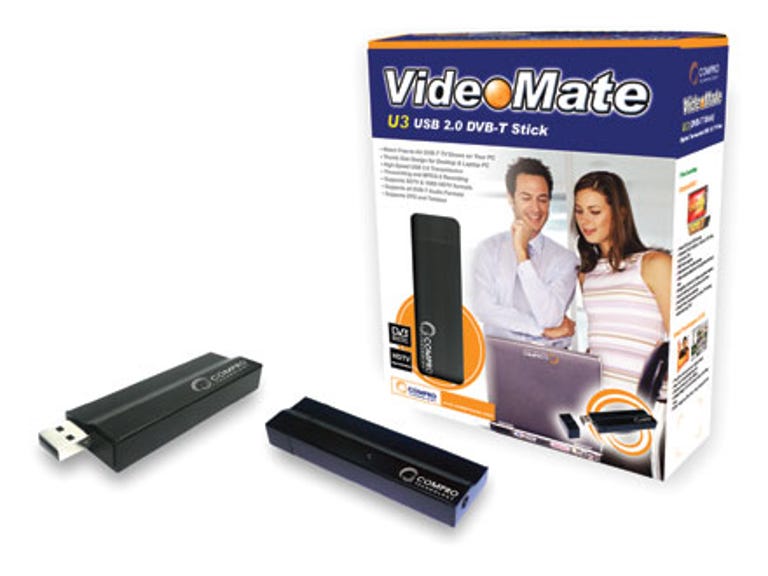 Why You Can Trust CNET
Why You Can Trust CNET ComPro VideoMate U3 DVB-T Stick review: ComPro VideoMate U3 DVB-T Stick
If you want a simple and inexpensive way to add digital TV viewing to your PC experience, then the Compro VideoMate U3 comes largely recommended.
Design
When we first pulled the Compro VideoMate U3 DVB-T Stick out of its packaging, the first thought that struck us was that it was an extremely fossilised Kit Kat that somebody had painted black, or perhaps an extra-long USB Memory key. It's neither of these things however -- and we'd warn anyone away from having a test chew on it, just to be sure. It is instead a USB 2.0-based digital TV receiver in a very small form factor, designed to add Media Center-style functionality to any Windows PC.
The Good
The Bad
The Bottom Line
The base "stick" comprises a USB plug at one end, and a small screw hole at the other. Into the screw hole you thread in a small and very tight-fitting coaxial connector, which can then be connected to the supplied tiny antenna, or any suitable antenna source that you have. It should be technically possible to use the VideoMate U3 to connect up other coaxial video sources, although we didn't test for this particular capability.
Features
Installation of the VideoMate U3 involves installing the drivers for the device as well as the accompanying Compro DTV2 Digital TV software, and optionally the Compro DVD viewing software and Ulead Photo Explorer 8.5 SE. Once you've installed the software -- and undergone the mandatory reboot sequence -- you'll end up with two system tray icons that launch the DTV2 software and scheduling package. The first time you run the software, it'll automatically scan for digital TV signals and assign them to whatever channels it picks up.
The supplied software can naturally enough be used for watching free to air terrestrial digital broadcasts, but it's also compatible with teletext services, EPG information and it can be used for recording programs as well. The software even supports picture-in-picture functionality, although naturally as it's only got a single tuner, that's a picture of digital transmission and a picture of playback of an existing file.
Performance
While the physical aspect of the package is perhaps the most minor part of the VideoMate experience, we did encounter one worrying aspect, and that was with the supplied coaxial adaptor. It's an extremely tight-fitting part, and in our tests tended to stay with the coaxial antenna cable, rather than the U3 Stick itself. That's a concern for two reasons. Firstly, it's an extreme struggle to remove it, and if you forget to, as it's a custom part, you'll find yourself with a black USB stick that's of practically no use at all -- at which time it may as well be a Kit Kat.
The other major hardware catch is with the supplied portable antenna. It's very small, and definitely portable, but within our testing environment in the north of Sydney, it captured exactly nothing in terms of viewable signal. Just as reception areas can vary widely, you may find it working better than we did, but for our actual testing we used a roof-mounted full-sized antenna instead.
The supplied TV viewing and recording software worked reasonably well, although we did find it something of a system hog. The package suggests that a Pentium 800 should be sufficient for TV watching, but that HD reception should require a P4 2.4Ghz machine -- that's quite a jump in capabilities, and if you're pondering this but stuck with a slower machine, you may find it all rather slow.
The VideoMate U3 definitely hits a sweet spot if you've got a solid enough machine to run it on -- and it's great in combination with a suitably fast laptop, especially if you're hankering after a Windows Media Center-style experience at a fraction of the overall cost of a Media Center notebook.


